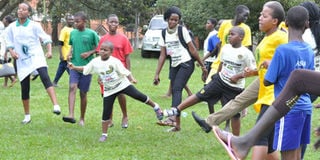Prime
Why children should exercise regularly

Children can keep active and fit by engaging in exercises such as physical education. Experts say many schools have ignored physical activity in favour of academics. File photo
What you need to know:
Dr Badru Matovu, a general practitioner at Kibuli Muslim Hospital, and Dr Rogers Mawanda, a sports medical therapist with the Uganda Volleyball Federation, highlight some of the exercises that children can engage in and their benefits
Many of us have heard or read about the benefits of keeping fit through regular exercise. For some, it is a recommendation from the doctor because of a particular health condition.
However, there are several benefits of keeping fit through exercise, including keeping weight in check and reducing obesity and other lifestyle-related diseases. But how many of these fitness programmes involve children? With a growing number of obese children, health experts say they need to be actively involved in different fitness programmes.
Dr Badru Matovu, a general practitioner at Kibuli Muslim Hospital, and Dr Rogers Mawanda, a sports medical therapist with the Uganda Volleyball Federation, highlight some of the exercises that children can engage in and their benefits.
Dr Matovu says children can indulge in activities such as jumping, rope-skipping and running. However, such exercises should depend on the age, weight, health and developmental status of the child. Dr Matovu says infants can be given dolls to play with, which arouses their mind and improves their speech.
Children who are below the age of two are usually inquisitive. This means they are eager to explore, and should therefore be left to play by themselves, but with close supervision from a caretaker.
At the age of three, children can engage in games such as running or jumping with their colleagues. Still, there should be someone to supervise them.
In this age group, children are also considered selfish, and can therefore harm each other while fighting for things such as dolls.
Dr Mawanda explains that walking enhances blood circulation, psychological and emotional development. It also improves the physical fitness of the child. Between the age of four and five, children can participate in games such as skipping, running or jumping. Such games improve their social skills.
Those above the age of five can engage in any activity of their choice under the guidance of a trainer.
Dr Matovu says from the age of six, children can play for up to six hours every day. “As children grow up, however, they limit their playing period. This is because they get involved with class work and other domestic chores,” says Dr Matovu.
Safety
Dr Matovu further notes that trainers should keep in close proximity of children as they engage in different exercise programmes.
A daily well-balanced diet is also crucial for children who are keen to keep fit through different exercises.
In this case, they need to eat foods that are high in nutrients such as carbohydrates, fats, proteins, vitamins, and minerals. “A balanced diet helps to keep children healthy and enhance fast growth. After having a meal, children should rest for about 30 minutes to allow the body breakdown the food, before they can take part in any exercise,” adds Dr Matovu.
Five to 10 years
Dr Mawanda says at this age, the exercise should focus on speed, intensity and load. Increasing intensity in workouts such as cycling, walking and skipping improves the skills of children.It also helps to increase alertness, coordination and agility.
10 years and over
In this age group, a trainer can put more emphasis on skills development, focusing on a particular workout or activity. Over the age of 10, a child can specialise in any sporting activity of their choice. This means that the instructor needs to develop the talent of the child in that particular activity.
Injury
Injury is a common occurrence during workouts. When a child has an injury, Dr Mawanda says the exercise that they engage should depend on the body part affected, magnitude of an injury and the child’s physical health. For instance, if the injury is on the hand, a trainer should engage the child in an activity that helps the hand heal faster.
Dr Mawanda says injuries on the leg can be managed by making a child walk short distances every often.
Walking helps in proper function and stability of the leg. It also steadily eliminates pain. This should however, be done within the first week of sustaining the injury.
Illness
In case a child is recovering from an illness, Dr Mawanda says tests should be carried out to establish the health of the cardiovascular and respiratory systems, before they engage in any activity.
During this period, children should not engage in any strenuous exercises. Swimming is a recommended workout for children who are recovering from an illness. This is because it helps to restore muscle activity and improve balance and coordination. Besides workouts, a child who is recovering from an illness should have a daily well-balanced diet.




